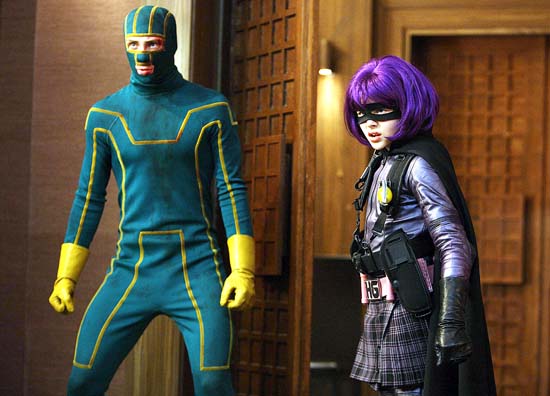From 2005’s “Sin City” to this summer’s upcoming “Jonah Hex,” stories from graphic novels are more frequently jumping off the page and onto the big screen. As the people behind the films profit from these large-scale productions, so do the people associated with the books.
“There has been a huge rise in the popularity of graphic novels in the past two decades. I would say that graphic novels account for roughly half our book sales,” said Robert Hennessey, co-owner of Hi De Ho Comics in Santa Monica. “You can partly attribute it to Hollywood in the most recent decade and partly to decisions made by comic book publishers.”
Graphic novels used to be published as monthly installments, but comic book companies such as DC and Marvel started collecting issues into single volumes around the ’90s. This newer business model is what made the graphic novel a book.
This form is what has allowed the graphic novel to acquire literary respect within the academic world. Critics cite “Maus” by Art Spiegelman as the first graphic novel to have done this. It is a Pulitzer Prize-winning narrative published in 1986.
“It was a Holocaust novel done in a medium and with a style that no one had ever thought to do before. It’s a memoir about this guy’s life and his relationship with his father and how his father had gone through the Holocaust. You’d never think to tell this story with mice,” said Bob Skir, a visiting assistant professor who teaches animation screenwriting.
Skir has always been a huge comic book fan. He came to UCLA during the ’80s to write screenplays based on comic books. Since then, he has written for animated series such as “Beetlejuice,” “Batman,” “Superman” and “X-Men.”
The graphic novel is now becoming more accepted as professors and graduate students use it in the classroom. Renee Hudson, a graduate student in the English department, used two graphic novels in the discussion section she taught for English 142B: “Shakespeare: Later Plays” to close read the presentation of sexuality in Lady Macbeth’s “unsex me” speech.
“We compared a graphic novel where Lady Macbeth’s whole body is covered with a Manga version set in a post-apocalyptic future, and since it’s Manga, it’s more sexual. She’s wearing this garter belt and she’s very scantily clad,” Hudson said. “I could have used film to analyze the sexuality, but graphic novels are frame by frame, and I wanted to slow down this visual imagery so we could analyze a single frame as opposed to the whole scene.”
Despite the value of the visual graphic novel, Hudson noticed that students were unfamiliar with the process of reading one.
“To a certain extent, there’s a discomfort of the graphic novel. I did feel that students are more traditional,” Hudson said.
Even though students may need more time to adapt to this new medium, she believes that using the graphic novel was effective in getting students to understand “Macbeth” and plans on using it more in future sections.
Not only is the graphic novel being used in the classroom, but it is also being written about in dissertations and journals at universities across the country. Drew Morton, a graduate student in cinema and media studies, is writing his dissertation on the relationship between comics and film.
“There’s been a profound influence behind the camera where you have comic book artists like Frank Miller going on to make films,” Morton said. “On the other end of things, you see Hollywood’s impact on comic book form as well. If a film is successful like “˜The Dark Knight,’ DC Comics reacts to all the culture of Heath Ledger, and they put out a book based on the Joker. It’s really a back and forth thing where books fuel the movies, and the movies go back to publishing.”
However, Morton noted that despite cultural visibility of graphic novels through these films and events such as Comic-Con, the annual comic book convention held each summer in San Diego, readership levels are surprisingly low.
“Comic book films are successful but not necessarily because they are based on comic books. They appeal to action fans through special effects and the spectacle,” Morton said.
Still, he believes this may change.
“When “˜Watchmen’ was coming out, everyone was reading it. My friend (who works) at Barnes & Noble said they had ordered 100 copies and had sold out really quickly,” Morton said.
Skir pointed out how timely these films are.
“There’s an appreciation for the graphic novel as a narrative form, and they finally have the technology to do these movies on the same scale,” Skir said.
The unique visual style that graphic novel adaptations commonly have are what make them so appealing to popular culture. Recent adaptations include “Kick-Ass”, which was expected to be extremely popular but experienced poor box-office performance.
Industry experts speculated that the film’s R-rating and extreme violence may have caused a decrease in ticket sales.
Coming this summer are two film adaptations, “Jonah Hex,” out June 18, and “Scott Pilgrim vs. the World,” out Aug. 13.
Based on the graphic novel of the same name, “Jonah Hex” stars Josh Brolin, Megan Fox and John Malkovich. Hex is a scarred hero and bounty hunter that survived an assassination attempt and is hired by the U.S. government to track down his enemy, Turnbull, played by Malkovich.
“Scott Pilgrim vs. the World” stars Michael Cera and Mary Elizabeth Winstead. In this adaptation, Scott Pilgrim is a teenager who falls in love with Ramona, a new girl in his town, and must defeat her evil seven ex-boyfriends to be with her.
The new trend of graphic novel adaptations has shown no sign of slowing down.
“We won. The geeks, the misfits, the comic book fans, people who would be hassled because they were reading comics. All the computer nerds around the world, like Bill Gates … these guys are rock stars,” Skir said.
